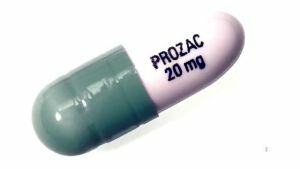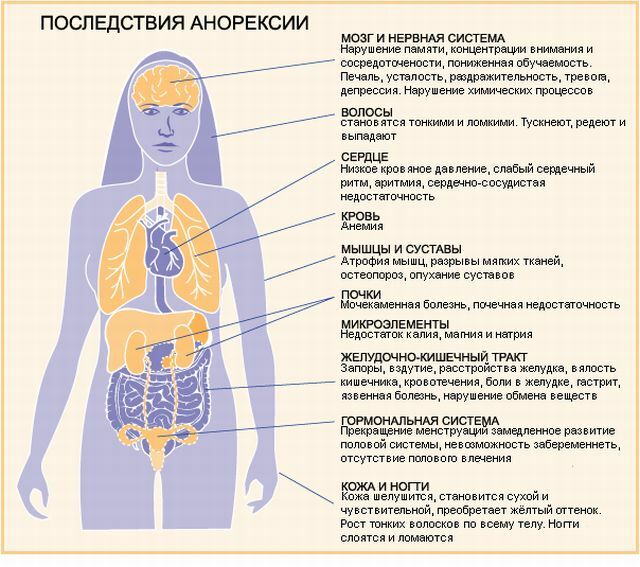 Anorexia nervosa is a psychological disorder that is characterized by a violation of the correct perception of one's body, fear of excess weight, restriction of oneself in food and a further change in the behavior of nutrition, i.e., a total refusal to eat.
Anorexia nervosa is a psychological disorder that is characterized by a violation of the correct perception of one's body, fear of excess weight, restriction of oneself in food and a further change in the behavior of nutrition, i.e., a total refusal to eat.
Most of the young people at risk are young women, girls and boys who are in transition.
Contents
- Stages of development of the disease
- What is the root of the evil?
- What does it look like in life?
- Tests for anorexia nervosa and diagnosis
- Approach to complex therapy
- Primary therapy
- Medication therapy
- Psychotherapy
- Consequences of the disease
- What to do close
Stages of the development of the disease
There are several stages of the course of anorexia nervosa:
- The initial stage( lasts several years) .During this period, distorted images of his body are formed, which lead to the most dangerous consequences. The opinion of others does not play any role for anorexic, he is completely confident that he looks bad. But an insignificant remark about his appearance can give rise to the development of this disorder.
- Anorectic .A person actively seeks to correct his physiological defects, that is, to lose weight. During this period somato-hormonal pathologies develop, there is a violation of the menstrual cycle or complete cessation of it. For the purpose of losing all kinds of methods are used, for example, heavy physical exertion, debilitating diets, taking medications diuretic or laxative, artificial vomiting. Disorders in the behavioral sphere begin to progress and add changes in the physiological nature: inflammation in the gastrointestinal system, omission of the abdominal organs, there are abdominal pain and stool( chronic constipation).After eating
 , you may experience asthma, palpitations, sweating, and dizziness. It is interesting that even with such a deficiency of nutrients and vitamins in the body, the patient remains physically active and workable.
, you may experience asthma, palpitations, sweating, and dizziness. It is interesting that even with such a deficiency of nutrients and vitamins in the body, the patient remains physically active and workable. - Categorical .Somato-hormonal disorders progress, menstruation stops, subcutaneous fat disappears completely, the skin and muscles undergo dystrophic changes, the heart rhythm weakens, low pressure and high body temperature prevail. Because of poor blood circulation, the patient constantly feels cold, his skin becomes bluish, becomes inelastic, the condition of hair, nails and teeth deteriorates, anemia develops. A person can not adequately assess himself and continues to refuse to eat well. Further, mobility is lost, anorexic spend most of the time lying in bed. Against the background of water-electrolyte imbalance, convulsions arise. This condition threatens the life of a person, so he needs inpatient treatment.
- Reduction( return) stage - relapse .After the course of therapy, there is an increase in weight, because of which the patient again have new delusions and phobias. He again becomes active and begins to use all means in order to get rid of extra pounds. That is why after leaving the third stage, anorexic drugs should be constantly under strict control of doctors and loved ones. Relapses can be observed for several more years.
What is the root of all evil?
There are a lot of reasons for anorexia, and in each case, one of the unfavorable factors can play a decisive role in starting a disease. These include:
- Physiological features of - completeness, early physical development, lacks in appearance.
- Character traits - low self-esteem, lack of self-confidence, the desire to be better, a sense of inferiority, a propensity for idealization.
- Psychological trauma .
- Socio-cultural factors .Such motivations are conditioned by the desire to conform to the norms and trends that modern fashion dictates.
- Heredity .A lot of studies have shown that there is a certain gene that can form a tendency to this pathology, that is, in the presence of other unfavorable factors, anorexia may develop in persons predisposed to the disease.
Huge importance is played by the presence in the family of sick relatives who suffered from mental disorders and alcoholism.
What does it look like in life?
All manifestations of the disease can be divided into several groups. The external symptoms of anorexia nervosa include:
- a sharp decrease in weight;
- haggard appearance;
- pallor, cyanosis and dry skin;

- puffy face;
- sunken eyes;
- brittle nails;
- rare dull hair;
- sluggish and tired appearance;
- slow growth( in adolescence);
- swollen joints;
- very often there is a loss of teeth.
Psychological signs:
- irritability and depression;
- emotional instability;
- memory degradation;
- inability to concentrate for a long time;
- appetite suppression;
- a constant fear of gaining weight;
- low self-esteem, obvious dissatisfaction with yourself;
- obsession with sports activities;
- the desire to be perfect;
- feelings of guilt and anxiety.
Behavioral traits:
- reduced portion of food;

- constant calorie counting and rejection of certain products;
- causing vomiting in order to get rid of the eaten;
- change in clothing preferences, a person tries to wear things that will maximally hide his "shortcomings";
- constant control of its weight;
- regular loss of consciousness;
- high level of self-criticism;
- refusal to communicate with loved ones, withdrawal into oneself.
Tests for anorexia nervosa and diagnosis
If symptoms of a disease appear, you should immediately call a specialist. To make an accurate diagnosis, use these methods:
- A personal conversation with a patient or his relatives .The conversation is conducted in order to determine the risk factors for the development of the disease, the detection of symptoms and existing complications.
- Calculation of body mass index .To do this, use a special formula: weight in kilograms divided by the growth in square meters. For example, if the body weight is 65 kg with an increase of 1 meter 75 centimeters, the BMI will be equal to 22.5.The optimal indicator is considered to be from 18.5 to 24.99.Indicators below this may indicate a pathology.
- Blood, urine, hormone analysis - is performed to determine the reduction of hemoglobin level, hormone deficiency and disturbance of water-electrolyte balance.
- Radiography of the skeleton - shows a thinning of the bones.
- Ultrasound of the stomach and intestines - reveals disease.
- Electrocardiography - Detects heart disease.

Approach to the comprehensive therapy of
Treatment of a patient with anorexia nervosa has three main objectives:
- return to normal physical state;
- return to the correct power mode;
- correction of ideas about yourself.
Primary Therapy
The form of therapy will be selected according to the degree of the disease. In general, the treatment is carried out in a hospital under the strict supervision of doctors.
In patients with severe anorexia, the normalization of body weight is carried out gradually - from 0.5 kg to 1.5 kg per week. An individual diet is prescribed, which ensures the intake of the necessary amount of nutrients in the body.
The diet will be based on the degree of exhaustion, BMI and symptoms of a deficiency of any trace elements. For example, with a decrease in bone density, food should contain a large amount of calcium.
Very good, if anorexic does not reject food and eats on its own. Otherwise, forced feeding using a probe is performed.
Medication Therapy
Treatment with medications involves coping with complications of the disease. In this case, 
- hormones will be prescribed: if the menstrual cycle is disturbed;
- calcium preparations, vitamin D - with a decrease in bone density;
- antidepressants : Prozac, Olanzapine - for the elimination of mental disorders.
The duration of the course of treatment and the dosage may be determined exclusively by the doctor in charge.
Psychotherapy
Psychological help in this case plays a huge, and sometimes decisive. The main task of a specialist is to identify negative thoughts and feelings that are crucial for an eating disorder and replace them with healthy adequate beliefs.
It is also very important to teach the patient to cope independently with negative emotions, problems in interpersonal relationships and direct their feelings in a positive direction.
In the treatment of anorexia, two areas of psychotherapy are used:
- familial - for adolescent patients;
- behavioral - for patients of adult age.
The length of the course will depend on the patient. In some cases, it may take several years.
Consequences of the disease
Nervously mental anorexia is fraught with very serious consequences. Here are some of them:
- Violation of the cardiovascular system .
- Pathological abnormalities in the endocrine system on the background of decreased production of triiodothyronine and thyroxine( thyroid hormones) and sex hormones. As a result, not only the menstrual periods cease, but the reproductive function also decreases, that is, the girl may not subsequently have children.
- Breast bone due to calcium deficiency in the body .Such people systematically suffer from various fractures.
- Inflammation of the esophagus and deterioration of the tooth enamel due to the effect of gastric acid, which is released with the constant provocation of vomiting.
- The frustration of the psycho-emotional sphere - such people are constantly depressed, irritable, emotionally unstable.
- The most terrible consequence of anorexia is lethal outcome of , which can happen if not in time do not pay attention to this problem and let the situation go by itself.

What to do with relatives
The role of native people in the rehabilitation of anorexic is simply enormous. If a family has such a problem, you need to understand how to behave. Here are some useful rules that will help you choose the right line of conduct:
- in the first place should go to a consultation with a psychologist;
- be a role model - healthy eating, good physical shape, sports;
- does not in any way criticize the appearance of others;
- to avoid threatening and intimidating tactics;
- protect the patient from the influence of any negative emotions and stresses;
- provide full psychological support.
 Only with the implementation of these instructions and with properly selected timely treatment can achieve good results and return a loved one to a normal state.
Only with the implementation of these instructions and with properly selected timely treatment can achieve good results and return a loved one to a normal state.
The danger of the disease lies in the fact that anorexic does not really understand that he is sick and wants to lose weight again and again. He does not perceive the words of those around him that he has lost weight, it seems to him that this is not true.
There is very little that depends on the patient himself in this situation, he is obsessed with his idea-fix, that's why the family should take part in the process of its return to normal life.



